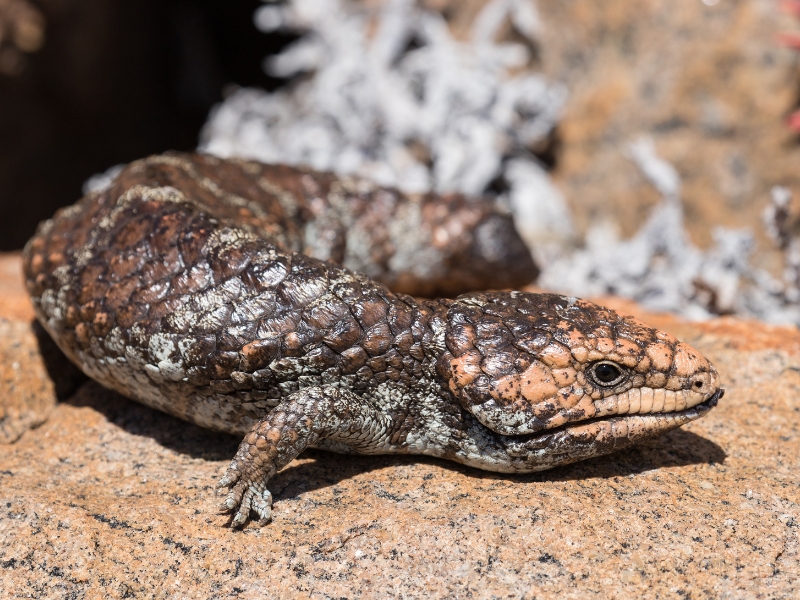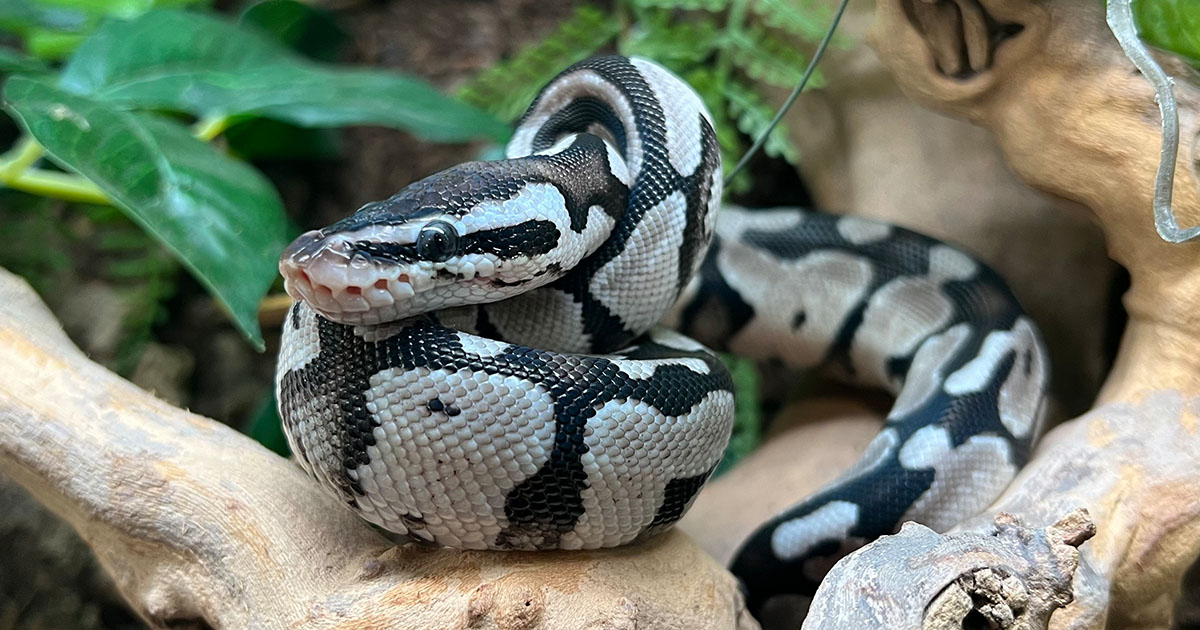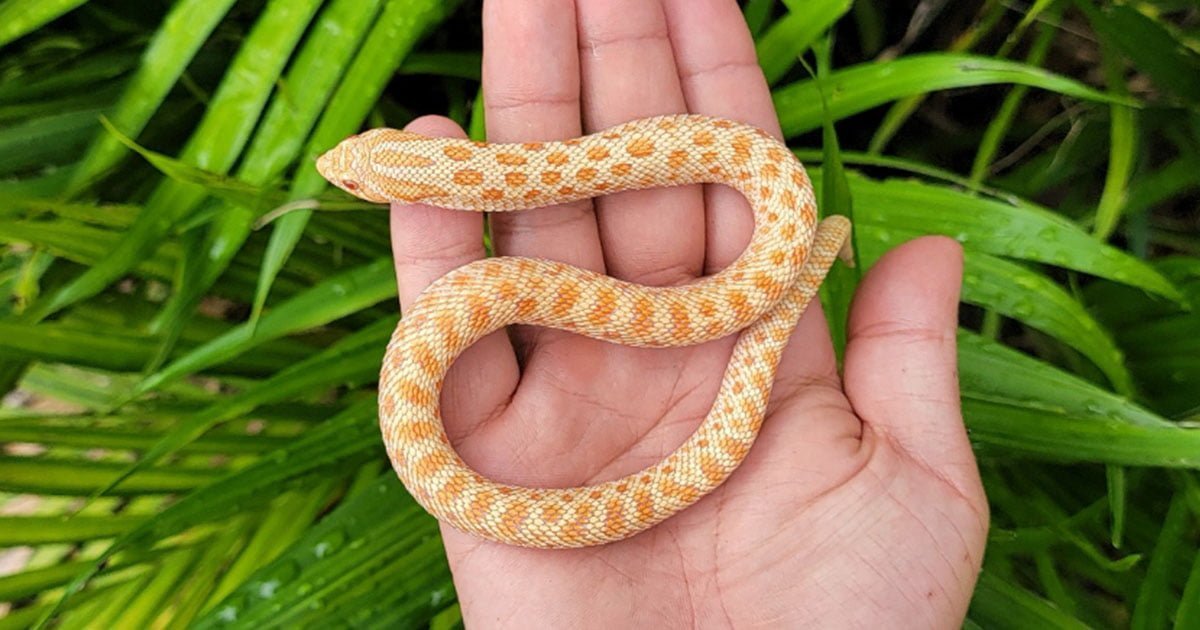The shingleback skink is well-known in its Australian homeland but less familiar to reptile fans in other countries. But, provided you purchase one from a reputable breeder, they are hearty, easy-to-handle reptiles that take well to captivity.
Read on to learn more about the care and keeping of shingleback skinks!
Quick Facts
| Common name | Shingleback skink, bobtail lizard, two-headed skink, pinecone lizard |
| Scientific name | Tiliqua rugosa |
| Adult size | 10″-18″ |
| Lifespan | 10-25+ years |
| Diet | plants, insects, snails |
| Tank size | 3′ x 2′ x 1.5′ or 10-20 gallons |
| Humidity & temperature | Humidity 20-40%; temperature 80-90F (incandescent lighting) |
| Popular alternatives | blue-tailed skinks, fire skinks |
Shingleback Skink Profile
The shingleback skink hails from Australia, where it’s sometimes known as the bobtail lizard, two-headed skink, or pinecone lizard.
In the wild, this lizard can move as much as 500 meters, or a third of a mile, daily. It’s also notable for its preference for monogamy. This setup helps young skinks get the care they need in the rough Australian outback.
While these reptiles are extremely popular pets in Australia, they’re less known and available in the US and other parts of the world.
Appearance
Shingleback skinks are slow-moving reptiles with armored bodies, blue tongues, and brown or beige coloring.
The broad tail is where they keep extra fat reserves to help them get through lean times in the outback. It also helps to confuse predators about which side of the body the head is on.
Size
These reptiles are generally about 10 to 12 inches long but can grow up to 18 inches. Male skinks are typically stockier and have larger heads than females, though females are often larger in general terms.
Cost
In Australia, shingleback skinks can be found for anywhere from $50AUD to $400AUD, depending on the seller. Outside of Australia, though, it’s a much different story.
Purchasing any exotic pet requires you to thoroughly vet any potential brokers. The market for these reptiles is often murky and confusing; you may be working with an unethical broker or even breaking the law without knowing it.
Because shingleback skinks make such good pets, the incentive is high to smuggle live animals out of Australia or breed them in a way that’s harmful to the animals. Do your homework to find a reputable breeder, and trust your gut if something doesn’t feel right.
You should also be aware that owning or importing one of these pets may mean applying for and paying for additional licenses or certificates. Check with your state and municipality to make sure you’re following the law.
Shingleback Skink Care Guide
Shingleback skinks are pretty easy to take care of, but they do have particular needs. When in doubt, try to keep the conditions similar to their home turf of southern Australia.
Tank and Enclosure
The ideal tank is a 10 or 20-gallon glass tank, ideally 3′ x 2′ x 1.5′ (L x W x H). Choose one big enough to give your lizard space to move around and several places to sit and bask.
Though skinks are larger than many domestic lizards, they can blend into their surroundings quite well. Limit the vegetation in the enclosure so you can always see where your pet is.
Skinks are known for being docile, but you should keep a lock on the top of the tank just in case. You should also keep the tank in a quiet room that you don’t use every day, like a guest room, office, or basement. Skinks have sound sensitivity close to that of humans.
The tank should include two shelters or hideaways where your pet can sleep. This will allow your skink to feel safe and secure while it rests. Try to position one near a heat source and one a little cooler and farther away.
Lighting and Heating
Australia is dry, hot, and fairly close to the equator. That means your shingleback skink needs lots of light and hot conditions.
Incandescent lighting is great for reptiles – you should keep the light on for at least 12 hours a day to mimic the conditions your skink is used to. Combined with a heating pad under the tank, the lighting can keep the environment around 80 to 90 degrees Fahrenheit.
You should also have a humidifier to track the tank’s humidity levels – ideally around 20-40%. You can keep an open water dish in the tank to serve as drinking water and humidity regulation.
Substrate
The substrate in your skink’s cage doesn’t have to be anything fancy. Newspaper, packing paper, or paper towels are all good choices. Avoid anything with glossy inks or smells to protect your reptile’s health.
Sanitation
You can use a commercial cleaning fluid, dish soap, or bleach to clean and sanitize your reptile’s enclosure. The most important things to remember are:
- Wear gloves and old clothes while cleaning to protect yourself.
- Rinse everything thoroughly.
- Dry the tank and accessories with paper towels before placing your pet back in.
- You can clean stubborn smells with just baking soda and water.
Diet
The shingleback skink loves insects, though it is an omnivore and will eat just about everything in captivity. Mealworms, crickets, wax worms, and silkworms are all good options.
The prey you feed your skink should be gut-loaded prior to feeding. If you’re unfamiliar with gut loading, it’s the act of feeding a nutritious meal to prey insects so they can be more nutritious for the predator pet.
The gut load you choose depends on your preferences and the needs of the skink. If they are showing signs of a particular vitamin deficiency, you should adjust the gut load accordingly.
You should only place prey in your skink’s enclosure when they’re awake. Some shingleback skinks are diurnal, while others are nocturnal. Keep an eye on your pet’s schedule and feed accordingly.
Shingleback Skink Health & Disease Guide
There are a few conditions common to shingleback skinks that you should be aware of.
Metabolic Bone Disease
Metabolic bone disease happens when a reptile doesn’t consume enough calcium, vitamin D3, or phosphorous. The bones weaken, and reptiles can be lethargic or, in extreme cases, have tremors.
To avoid MBD, ensure your pet receives enough calcium and phosphorous in its diet. You can have a UVB lamp in their cage for vitamin D3, or you can add it to their diet as a supplement.
Mouth Rot
The mouth of a reptile contains plenty of bacteria, but with a normal immune system, this isn’t an issue. However, when reptiles are stressed or in an environment that doesn’t have the right humidity, their immune system weakens. If there’s a cut or a piece of food is stuck in their mouth, the wound can become infected.
A shingleback skink with mouth rot may have pus or fluid draining from the nose and throat. Their mouth may be inflamed, and they may lose their appetite.
Because mouth rot and a weakened immune system can have several causes, it’s important to take your pet to the vet as soon as you notice symptoms.
Parasites
Reptiles can get parasites from their food, environment, and other animals in their enclosure. While some dangerous parasites may just pass through a healthy lizard, if they are already ill or have a weakened immune system, an infection can occur.
Signs of a parasite include loose stools, weight loss, a loss of appetite, and a distended abdomen.
Take your pet to the vet for an annual fecal swab to check for parasites and when you suspect parasitic infection. Parasites from fleas and ticks, in particular, can spread to other pets in your household or even humans.
Shedding
Adult shingleback skinks typically shed once every few months. They may experience difficulty shedding skin occasionally and have flakiness, skin sticking to their tails or eyes, and restlessness.
Stuck skin can impair your pet’s mobility, so if you notice them having shedding trouble, stick them in a warm water bath for a few minutes. This may be enough to loosen the skin.
If there’s still stuck skin that won’t come off with gentle handling, take your skink to the vet right away. Don’t attempt to use tweezers or scissors to cut it off – those are good ways to wound your pet.
Respiratory Conditions
Reptiles in cold, dry, or dirty conditions can develop respiratory infections. If you notice discharge from your lizard’s nose or mouth or if they’re breathing audibly, take them to a vet right away.
Lifespan
While the typical lifespan of a shingleback skink is 10-15 years, skinks almost 50 years old have been found in the wild. If you care for your pet well, you can expect to share a decade or more with it.
Shingleback Skink Behavior
Shingleback skinks are known for their docility, especially when compared with other reptiles from Australia. However, it’s always best to understand your new pet as thoroughly as possible – it has needs!
Handling
Shingleback skinks are docile and generally don’t mind being handled. They aren’t apt to wriggle away when you have them in your hands.
However, skinks can engage in aggressive behavior if they feel threatened. They will open their mouth and stick out their tongue to attempt to scare the threat away. It may also hiss and flatten its body.
If you handle a stressed or threatened skink, it may bite. Its bites can sting, but this lizard doesn’t have any venom or poison. However, reptile bites must be thoroughly cleaned and observed since reptiles have different mouth bacteria.
Shinglebacks aren’t good climbers, so they can be kept in a tank with lower sides. This species was also once nocturnal but appears to have evolved to be more active during the day.
Keep an eye on your pet’s sleep/wake schedule and follow its lead when it comes to feeding times.
Brumation
Brumation is a period where reptiles become dormant and slow down their body activity. The shingleback skink carries large fat reserves in its tail to survive through brumation.
In the wild, shingleback skinks typically brumate during the Australian winter, from June to August. Your skink has likely been raised in captivity, so it may have a different brumation cycle, or it may not brumate on its own.
A brumating pet will still need water, so keep its water dish full. You may also want to schedule your vet visit right before brumation, as unwell pets may not survive the brumation process.
Reproduction
The shingleback skink is a viviparous reptile, meaning it gives live birth. The offspring are generally large – one can be as much as 35% of its mother’s weight.
Understandably, brood size is typically small, with only 2 or 3 offspring, though there may be as few as one or as many as four.
Newborns
A female will give birth to her brood about 3-5 months after mating. The newborns are birthed along with a well-developed placenta that they eat for a burst of nutrition and antibodies.
Babies are born ready to take care of themselves. They’ll likely spend the first few days with their mother, but they soon shed their skin for the first time and set off on their own.
Youth and Maturity
Shingleback skinks take about 3 years to fully develop. Males and females develop at roughly the same rate and don’t show different sex characteristics until adulthood.
You can expect your skink to live 10-15 years in captivity, perhaps a bit longer.
Fire Sensitivity
Skinks are incredibly sensitive to the smell of smoke. This is understandable when you consider that almost their whole native territory is prone to bushfires. You may notice your pet pacing in its enclosure if it can smell smoke in the air.
Shingleback Skinks – A Great Pet
Shingleback skinks can be hard to find, but they are great pets and pretty easy to take care of. They can be a great addition to your reptile menagerie.
Especially if you’re buying a shingleback skink outside Australia, ensure you’re buying from a reputable breeder and never be afraid to ask hard questions. Your new pet is a big responsibility, and that starts with making a responsible buying decision!



